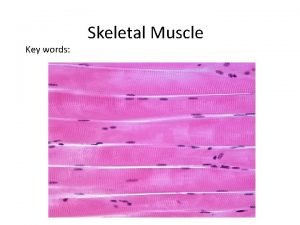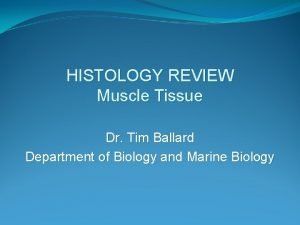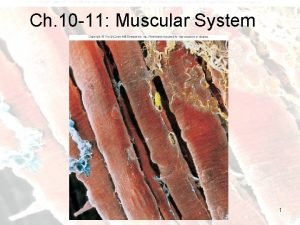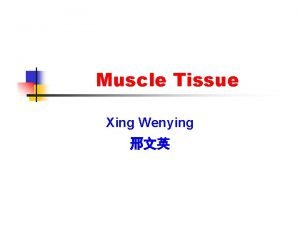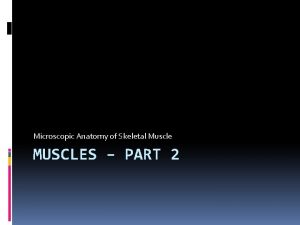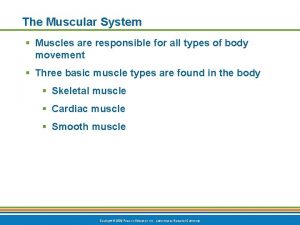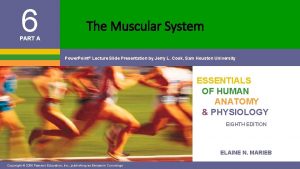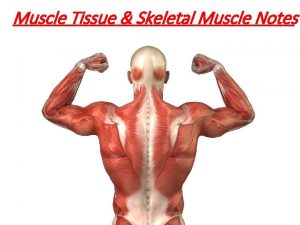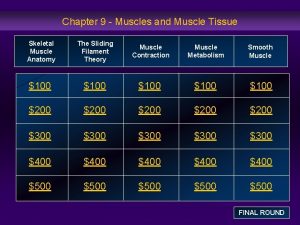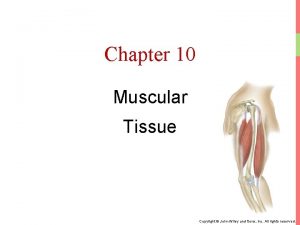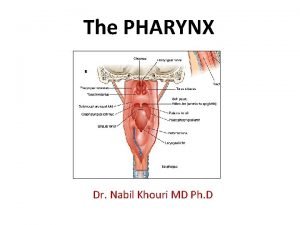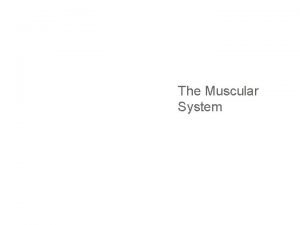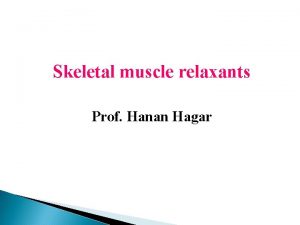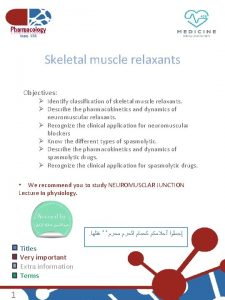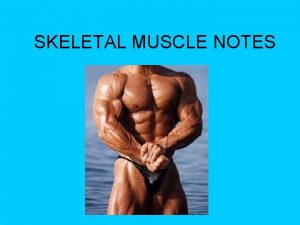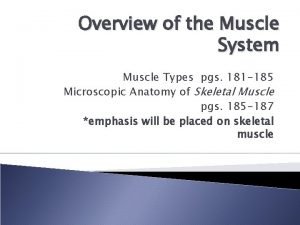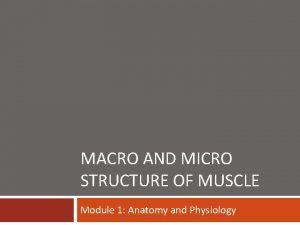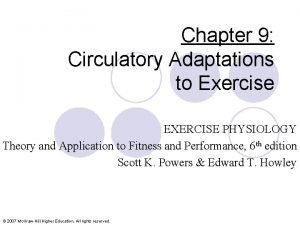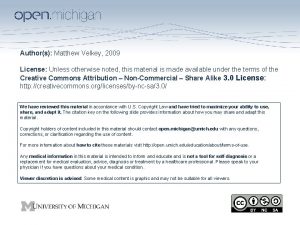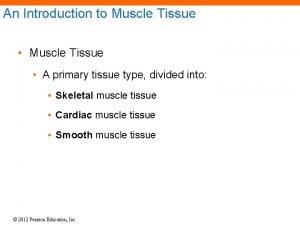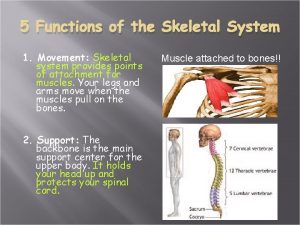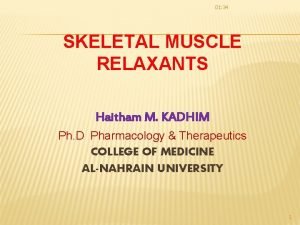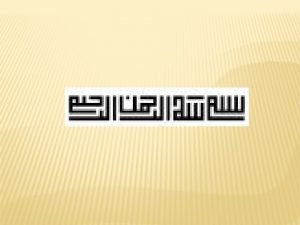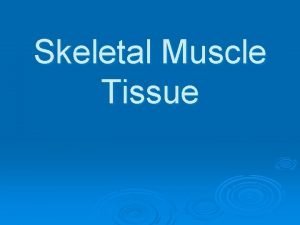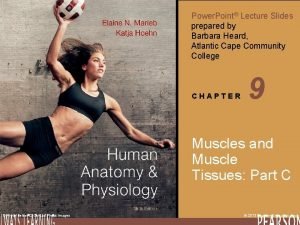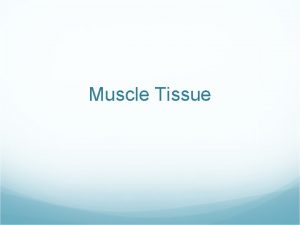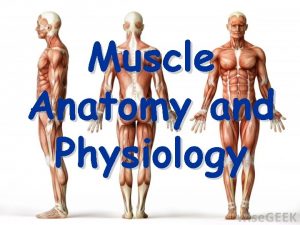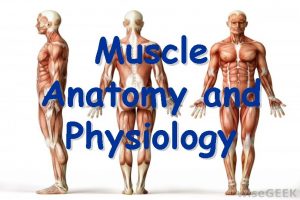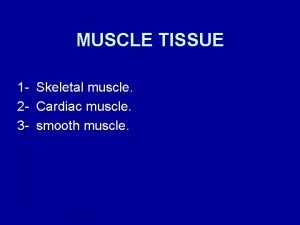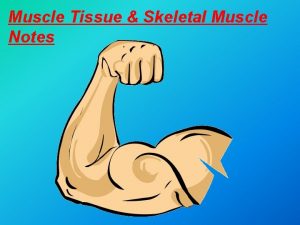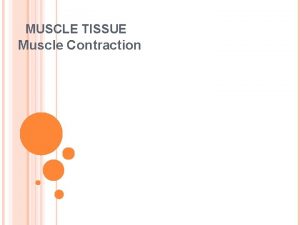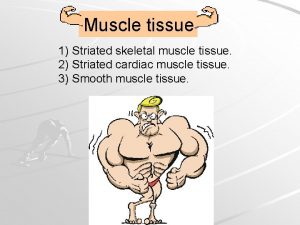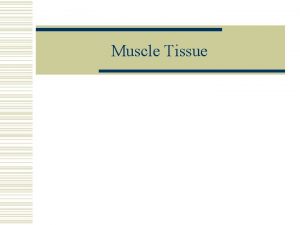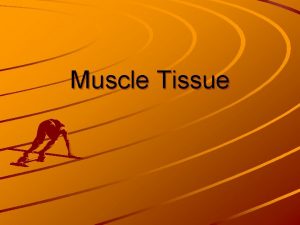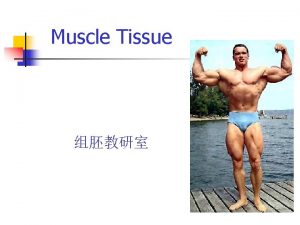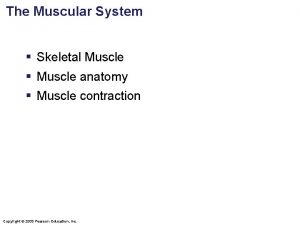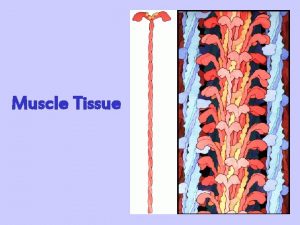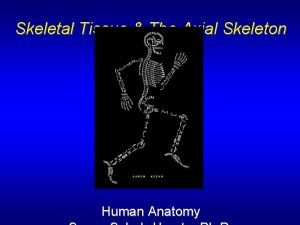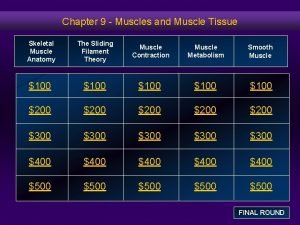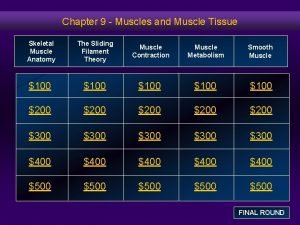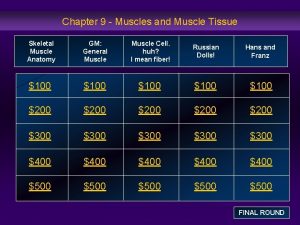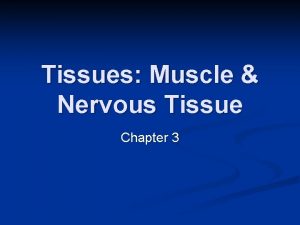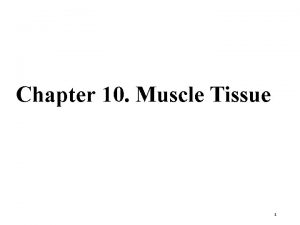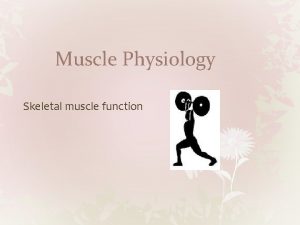Skeletal Muscle Tissue Chapter 10 Human Anatomy 3
































- Slides: 32

Skeletal Muscle Tissue Chapter 10 Human Anatomy, 3 rd edition Prentice Hall, © 2001

Introduction • Muscles are responsible for movement – Contraction & relaxation • Muscles make up 40 – 50 % of a human’s total body weight Human Anatomy, 3 rd edition Prentice Hall, © 2001

Characteristics of Muscle Tissue • Excitability – Can receive & respond to stimuli • Contractility – Can shorten & thicken • Extensibility – Can be stretched • Elasticity – Can return to its original shape Human Anatomy, 3 rd edition Prentice Hall, © 2001

Functions of Muscle Tissue • Motion • Maintenance of posture • Heat production Human Anatomy, 3 rd edition Prentice Hall, © 2001

Kinds of Muscle Tissue • Skeletal Muscle • Cardiac Muscle • Smooth Muscle Human Anatomy, 3 rd edition Prentice Hall, © 2001

The Muscular System • Muscle tissue = all contractile tissue • Muscular system = – Skeletal muscle tissue – Connective tissue Human Anatomy, 3 rd edition Prentice Hall, © 2001

Fascia of Skeletal Muscle • Epimysium – Wraps muscle • Perimysium – Divides muscle into bundles (fasciculi) • Endomysium – Separates each muscle cell Human Anatomy, 3 rd edition Prentice Hall, © 2001

Fascia of Skeletal Muscle

Tendons & Aponeuroses • Epimysium • Perimysium • Endomysium Human Anatomy, 3 rd edition Prentice Hall, © 2001

Tendon Sheaths

Nerve & Blood Supply • Related to contraction • Artery and 1 or 2 veins accompany each nerve – Each muscle cell is in contact with capillaries • Each muscle cell is in contact with a portion of a nerve cell – Neuromuscular junction Human Anatomy, 3 rd edition Prentice Hall, © 2001

Histology of Skeletal Muscle Tissue • Muscle fibers = elongated cells – – – Sarcolemma Sarcoplasmic reticulum T tubules Triad • Muscle fibers consist of myofibrils • Extend length fiber of • Myofibrils consist myofilaments of • Thin filaments • Thick filaments Human Anatomy, 3 rd edition Prentice Hall, © 2001

Myofilaments • Myofilaments do not extend entire length of fiber. • Stacked in compartments = sarcomeres – Partitioned by Z lines – A band (dark) – contains thick filaments • Includes H zone, zone of overlap – I band (light) – thin filaments only – H zone – thick Human Anatomy, 3 rd edition filaments only Prentice Hall, © 2001

Myofilaments • Thin filaments – Composed mostly of actin – Contain tropomyosin and troponin – Double-stranded coil • Thick filaments – Composed mostly of myosin – Rod-shaped (tail) with head Human Anatomy, 3 rd edition Prentice Hall, © 2001

Contraction – Sliding Filament Theory • Thin filaments slide inward toward the H zone – Z lines are drawn toward the A band • Sarcomere shortens • Lengths of myofilaments do not change • Cross bridges of thick filaments connect with actin • Width of the H zone gets smaller Human Anatomy, 3 rd edition Prentice Hall, © 2001

Neuromuscular Junction • Contraction requires a stimulus • An axon comes into close contact with a muscle membrane – Motor end plate • Acetylcholine transmits nerve impulse to the motor end plate – Initiates contraction • Axon terminal + motor end plate = neuromuscular junction Human Anatomy, 3 rd edition Prentice Hall, © 2001

Motor Unit • Def. – motor neuron and all muscle cells it stimulates • 1 motor neuron may innervate few or many muscle cells • The number of muscle fibers/motor unit determines how precise a movement is. Human Anatomy, 3 rd edition Prentice Hall, © 2001

Physiology of Contraction – Relaxed Muscle • Sarcoplasm is low in calcium • ATP is bound to myosin cross bridges • Tropomyosintroponin complex is attached to actin Human Anatomy, 3 rd edition Prentice Hall, © 2001

Physiology of Contraction – Stimulation of Muscle • • • Nerve impulse reaches motor end plate Neuron releases ACh Electrical charge travels along sarcolemma Electrical charge travels down T tubules Electrical charge travels to S. R. releases calcium into sarcoplasm Human Anatomy, 3 rd edition Prentice Hall, © 2001

Physiology of Contraction – Activation of Myosin • Calcium binds to troponin • Cross bridges form • Calcium acts as an enzyme – Breaks down ATP to ADP + P • Myosin cross bridges move • Sarcomere shortens • Muscle shortens Human Anatomy, 3 rd edition Prentice Hall, © 2001

Physiology of Contraction – of Muscle • • • Relaxation Nerve impulse ends ACh is broken down by acetylcholinesterase Calcium is actively transported back into S. R. ADP + P = ATP – Binds to cross bridges Myosin cross bridges separate from actin Binding sites on actin are covered Thin myofilaments slip back to resting position Sarcomeres return to resting length Muscle fiber returns to resting length Human Anatomy, 3 rd edition Prentice Hall, © 2001

Physiology of Contraction

Fast, Slow, and Intermediate Muscles • Duration of contraction varies with function • Fast muscles (white) – More extensive SR – Lack myoglobin – Fewer capillaries • Slow muscles (red) – Smaller fibers – More capillaries – Lots of myoglobin Human Anatomy, 3 rd edition Prentice Hall, © 2001

Disorders • • • Fibrosis Fibrositis Fibromyalgia Muscular dystrophy Myasthenia gravis Human Anatomy, 3 rd edition Prentice Hall, © 2001

Classifications in the Muscular System Human Anatomy, 3 rd edition Prentice Hall, © 2001

• • How Skeletal Muscles Produce Movement Exert force on tendons Attached to articulating bones forming a joint When muscle contracts, one bone moves toward the other Attachments – Origin = attachment to stationary bone – Insertion = attachment to moveable bone – Belly = fleshy portion of muscle between tendons Human Anatomy, 3 rd edition Prentice Hall, © 2001

Arrangement of Fasciculi • Parallel • Convergent • Pennate – Unipennate – Bipennate – Multipennate • Circular • Arrangement is correlated with the power and range of movement of a muscle. Human Anatomy, 3 rd edition Prentice Hall, © 2001

Arrangement of Fasciculi

Group Actions • Agonist or prime mover – Causes desired action • Antagonist – Effect is opposite to agonist • Synergist or fixator – Assists agonist Human Anatomy, 3 rd edition Prentice Hall, © 2001

Lever Systems • Bones = levers, joints = fulcrums • Levers are acted upon by resistance, effort • Types – 1 st class lever - fulcrum is placed between effort and resistance – 2 nd class lever - fulcrum is at one end, effort is at the opposite end, resistance is in between – 3 rd class lever - fulcrum is at one end, resistance is at the opposite end, effort is in between • Leverage is responsible for a muscle’s strength and range of movement Human Anatomy, 3 rd edition Prentice Hall, © 2001

Classes of Levers

Naming of Skeletal Muscles • • Direction of muscle fibers Location Size Number of origins Shape Origin & insertion Action Human Anatomy, 3 rd edition Prentice Hall, © 2001
 Skeletal muscle
Skeletal muscle Cross section of skeletal muscle
Cross section of skeletal muscle Skeletal muscle tissue structure
Skeletal muscle tissue structure Smooth mucle
Smooth mucle Smooth muslce
Smooth muslce Microscopic anatomy of skeletal muscle
Microscopic anatomy of skeletal muscle Microscopic anatomy of skeletal muscle figure 6-2
Microscopic anatomy of skeletal muscle figure 6-2 Chapter 6 the muscular system figure 6-9
Chapter 6 the muscular system figure 6-9 Microscopic anatomy of skeletal muscle
Microscopic anatomy of skeletal muscle Skeletal muscle
Skeletal muscle Male vs female skeleton pelvis
Male vs female skeleton pelvis Muscles and muscle tissue chapter 9
Muscles and muscle tissue chapter 9 John wiley
John wiley Pharyngeal wall layers
Pharyngeal wall layers 5 golden rules of skeletal muscle activity
5 golden rules of skeletal muscle activity Centrally acting skeletal muscle relaxants
Centrally acting skeletal muscle relaxants Dantrolene
Dantrolene Classification of skeletal muscle relaxant
Classification of skeletal muscle relaxant Gangelia
Gangelia Movable muscle
Movable muscle Comparison of skeletal cardiac and smooth muscle
Comparison of skeletal cardiac and smooth muscle Skeletal muscle relaxants classification
Skeletal muscle relaxants classification Characteristics of skeletal smooth and cardiac muscle
Characteristics of skeletal smooth and cardiac muscle Micro muscles
Micro muscles Organisation of muscle
Organisation of muscle Skeletal muscle pump
Skeletal muscle pump Cardiac muscle cross section
Cardiac muscle cross section A&p flix activity: resting membrane potential
A&p flix activity: resting membrane potential 5 functions of a skeleton
5 functions of a skeleton Skeletal muscle relaxants classification
Skeletal muscle relaxants classification Nerve supply skeletal muscle
Nerve supply skeletal muscle Skeletal muscle belly
Skeletal muscle belly Comparison of skeletal cardiac and smooth muscle
Comparison of skeletal cardiac and smooth muscle
